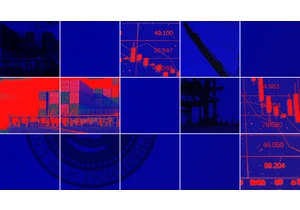A few years ago, Nick Milo was using a folder full of plain text files for notes when he found out about Obsidian.
The app had just launched in beta, and was getting some buzz on a productivity forum that Milo liked to frequent. Obsidian gave structure to text files in a way that resembled more popular apps such as Notion and Evernote, and it didn’t take long for him to get hooked on the app.
“Immediately, I recognized that they had cracked the code,” he says.
Milo has since become one of Obsidian’s most outspoken users, with a popular YouTube channel and e-course that calmly explains not just how to use Obsidian, but why. (A popular comment on his first video: “This wasn’t a product walkthrough. This was a guided meditation.”)
He’s not alone in seeing the light: Obsidian estimates that it has one million users, and its Discord channel has more than 110,000 members, who use the app for everything from task management and bookmarking to organizing their daily thoughts. On Reddit, Obsidian ranks in the top 5% of communities, with 94,600 members. All this happened without any venture capital backing or outside investment.
Obsidian’s grassroots success is all the more remarkable given that the app isn’t especially inviting to nontechnical users. While apps like Notion put all your notes in the cloud so you can instantly access them from anywhere, Obsidian gives users a folder full of files and puts them in charge of managing it. Using Obsidian also requires some familiarity with Markdown—a text-editing language with its own unique syntax—and leans on third-party plug-ins for features that are table stakes in other note-taking tools.
But that nerdiness is also part of its allure: Once Obsidian endears itself, it’s hard to imagine using much else.

Building the grassroots
Erica Xu and Shida Li started working on Obsidian in 2020 while quarantining during the pandemic. The two engineers had met at University of Waterloo, and had previously developed a task management app called Dynalist.
In an interview with Ness Labs, Xu said she was scratching a personal itch. She had tried to create personal wikis for herself, but other tools such as MediaWiki and TiddlyWiki never clicked, and with note-taking apps, there was always one particular feature that wasn’t available or didn’t quite work as intended.
In a nod to extensible code editors, she came up with the idea of a plug-in system that Obsidian even uses for its core features. This allows users to replace elements such as the word count with third-party alternatives, or even bolt on new features such as kanban boards and freeform drawing.
Xu and Li then turned to Discord, both to distribute early betas and spark the plug-in system. Speaking to Robert Haisfield, Li said he drew on his past experience as a gaming community moderator to set up Obsidian’s community as a welcoming space, with mods acting as role models.
Eleanor Konik, a fantasy author who helps moderate the Obsidian Discord and writes a popular newsletter about Obsidian updates and plug-ins, says the result feels something like a mentorship program for aspiring JavaScript programmers. Especially in the early days, the developers would spend a lot of time not just making sure plug-ins worked properly, but that people were learning along the way.
“You just don’t get the kind of dudebro, single, angry, San Francisco, bent-on devouring-the-world kind of aggressiveness and posturing that you get from a bunch of 22-year-old hotshot developers,” Konik says.
When the time came for Obsidian to expand its team, Xu and Li hired from within. For CEO, they brought on Stephan Ango, who co-founded and sold the packaging startup Lumi, after he developed Obsidian’s Minimal theme and helped out with their version 1.0 release last year. They also hired several other plug-in developers as engineers.
“They’ve been slowly expanding the team, but they’ve been expanding from the userbase, which gives them more of a force multiplier, because the people they’re hiring really know the community,” Konik says.

Making it their own
The bottom-up nature of Obsidian is also reflected in the app itself. Milo says one thing that drew him to Obsidian is how it’s not prescriptive about organization. In addition to a traditional folder structure, users can view a graph that shows all the links between their notes. They can also use the Bookmarks section arrange notes independently of their file system, Another recent feature called Canvas lets users arrange notes on a pinboard, alongside comments, images, and embedded web pages.
“With Obsidian, you can still have folders, you can do all that, but it allows a looseness, more of a bottom-up chaotic energy, where you can connect things even if you don’t know where that’s going,” Milo says.
Obsidian’s approach has also made for some surprising converts.
John Voorhees, the managing editor at MacStories, started using Obsidian a couple of years ago after being drawn to its local file structure, and both he and MacStories founder Federico Viticci have written extensively about their Obsidian setups since then.
Obsidian is on some ways the opposite of a quintessential MacStories app—the site often spotlights apps that are tailored exclusively for Apple platforms, whereas Obsidian is built on a web-based technology called Electron—but Voorhees says it’s his favorite writing tool regardless. He and Viticci have even commissioned some bespoke plug-ins for their Macstories workflows.
“No matter what your writing needs are, there’s probably a plug-in to satisfy them,” he says.
Staying small
About a month ago, Ango went on social media to draw some lines in the sand about Obsidian’s future. On X and Mastodon, he declared that Obsidian has no plans to grow beyond a dozen employees and would never raise venture capital.
Ango is clear-eyed about the limitations of that approach. It means Obsidian can’t develop new features as quickly as other apps, and it can’t chase growth by offering its paid services below cost. But the self-imposed limits, he said, are a way to uphold the company’s values. (Ango has also written an impassioned defense of the computer file, at a time when cloud-based apps are increasingly moving away from the idea.)
“We want to build Obsidian as a team with a flat hierarchy and few meetings,” Ango says via email. “We want everyone to be a contributor, and have a high level of craftsmanship and focus. We want the files our users create with Obsidian to be durable, and not locked into proprietary platforms.”
Keeping the team small and spurning outside investment is Obsidian’s way of avoiding incentives that might lead the company astray.
We are lucky to be building Obsidian at a time when it is possible to build a complex, multi-platform app with millions of users — while remaining a very small team,” Ango says. “We want to find out how far we can take that experiment.”

Obstacles ahead
Obsidian doesn’t collect usage data, so it doesn’t know exactly how many people are using it. Based on the number of downloads from its GitHub page, Ango estimates that Obsidian has roughly 1 million users. Notion, by comparison, boasted of 20 million users in 2021 (though it hasn’t updated that figure since).
Even Obsidian’s most dedicated users don’t expect it to take on Notion and other note-taking juggernauts. They see Obsidian as having a different audience with different values.
“The people who are sitting around hacking on the incredibly flexible, but kind of difficult-to-use and not immediately intuitive and beautiful Obsidian, are not the same kind of people making Notion databases,” Konik says.
Still, there’s a desire—even within Obsidian—to make the app a bit less intimidating. The software has improved in this regard, most notably by removing Markdown syntax from its main editor (in favor of a “Live Preview” mode) in late 2021, but users are still expected to know Markdown for formatting. Some creature comforts from other modern note-taking (such as Notion’s handy slash command menu) are absent.
That’s one reason Jean-Pierre Cen started building Make.md about a year ago. It’s an ambitious plugin that tries to smooth some of Obsidian’s rough edges—for instance by adding a pop-up formatting menu for selected text—and its Folder Note feature is similar to Notion’s system of branching subpages.
“I just want more people to be able to use Obsidian,” Cen says.
Such statements might not seem contentious, but within the Obsidian community there’s a wariness of tools that deviate too much from the core Markdown file structure. Cen calls it “Markdown maximalism,” and says it can sometimes be self-defeating.
“I don’t want to say gatekeeping, but sometimes it feels like that to people who are coming in,” he says.
Still, Nick Milo, who’s somewhat skeptical of ambitious plugins such as Make.md, says he’d like to see Obsidian absorb the functionality of more plug-ins and turn them into core features. And even Obsidian recognizes that its learning curve could be gentler.
“Our goal for Obsidian is to continue making the app even more approachable for new users, while retaining an infinite level of depth that you can explore through advanced features and plugins,” Ango says.
There’s also the question of making money. Obsidian is free for personal use, and while it requests $50 per user, per year for teams of two or more, it has no way of enforcing its licensing rules give that it doesn’t track users. (Individuals can also show support with a $25 one-time contribution, which also opens up access to beta releases.)
Beyond the software itself, Obsidian offers a couple of paid services, each costing $10 per month or $96 per year: Sync offers end-to-end encrypted vault storage, while Publish lets users put their notes on the web.
At the same time, Obsidian allows users to assemble their own alternatives for free or cheap. You can use your own file sync system instead of Obsidian’s, for instance, and a quick search of Obsidian’s plug-in store reveals plenty of options for publishing notes to the web. Even Obsidian’s most passionate users note that it’s not an ecosystem geared toward making money.
“You can almost always find something for free, because some guy will get pissed off that somebody is charging money for something he views as trivially simple,” Konik says.
But maybe that’s okay. Obsidian’s low overhead and ambivalence about growth allows those money-making limitations to be sustainable, and the idea that Obsidian’s own users can compete on some level with the company’s paid offerings is part of why people love the app. It’s a rejection of how modern software is supposed to work, and it’s slowly gaining momentum.
“Why would I pay a cloud service to work slower? Just because it looks nice?” Milo says. “There’s a huge silent majority of individuals who have a similar sentiment.”
Connectez-vous pour ajouter un commentaire
Autres messages de ce groupe

When Donald Trump returned to the White House in 2025, many in the tech world hoped his promises to champion artificial intelligence and cut regulation would outweigh the risks of his famously vol

The first 27 satellites for Amazon’s Kuiper broadband internet constellation were launched into space from Florid

There are so many ways to die. You could fall off a cliff. A monk could light you on fire. A bat the size of a yacht could kick your head in. You’ve only just begun the game, and yet here you are,

Former Tinder CEO Renate Nyborg launched Meeno less than two years ago with the intention of it being an AI chatbot that help

The most indelible image from Donald Trump’s inauguration in January is not the image of the president taking the oath of office without his hand on the Bible. It is not the image of the First Lad

Ernest Hemingway had an influential theory about fiction that might explain a lot about a p

The first 100 days of Trump’s second presidential term have included a surprising player that doesn’t seem likely to go away anytime soon: Signal.
The encrypted messaging pl
